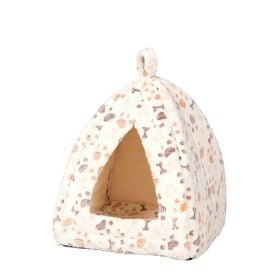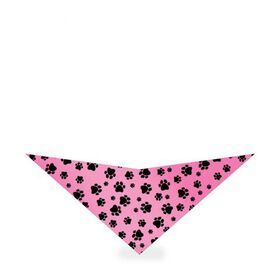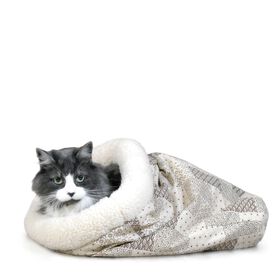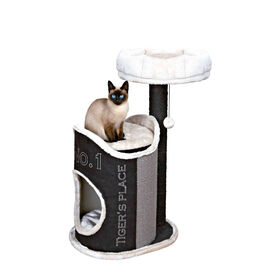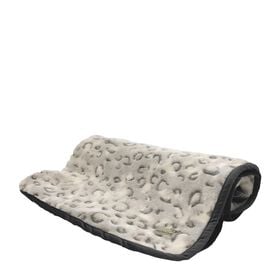The Peterbald is relatively new in the history of cat breeds. The breed gets the "Peter" in the name from St. Petersburg, the city in Russia where it was created, and the "bald" from the mostly hairless coat resulting from its hair-losing gene. This dominant gene, which differs from the recessive gene responsible for the hairlessness of the sphynx, is not yet fully understood. It can cause hairlessness, but also hair loss or a change in hair quality, sometimes in the same animal. Peterbalds are unique and well worth discovering.
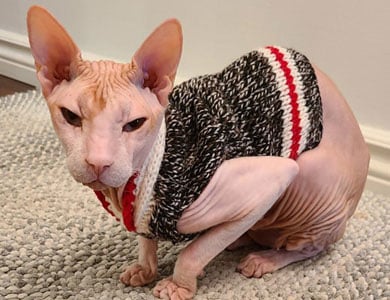
Morphology and appearance
With a long, lean body shape, Peterbalds have an Oriental morphology. Their head forms a long, narrow triangle, with a straight profile and wedge-shaped muzzle. They have large, almond-shaped eyes, slanting slightly toward the nose. Their large, set-apart ears are quite low on the head. They have a long neckline, and their tubular body is lean and muscular. They have long, delicate legs and small, oval paws with agile toes. Their slim tail attractively complements the slender appearance.
The Peterbald's main characteristic is its coat, or rather its lack thereof. There are five types of Peterbalds, based on the appearance of the coat:
- Bald: no hair at all on the body. If a kitten is born bald, it will remain bald all its life. It is considered homozygous to the hairlessness gene, and will always pass on the gene to its offspring.
- Flocked: 90% hairless, with a fine fuzz resembling peach skin
- Velour: 70% hairless, with a short, fine, downy soft coat of variable length
- Brush: a sparse coat of coarse, curly or dense hair, about 5 mm long. The breed-specific hair has a texture that feels like felt or several-day-old stubble.
- Straight coat: regular coat in terms of length and texture. These cats do not have the gene that modifies their hair, and are kept only as pets.
Kittens born with hair can change coat types
from two months to approximately two years. Sometimes, with multi-coloured cats, the white parts of the coat are velour while the coloured parts are brush. Peterbald whiskers are often a grab bag as well, sometimes appearing curled, broken or barely there. Peterbalds come in all cat colours and patterns.
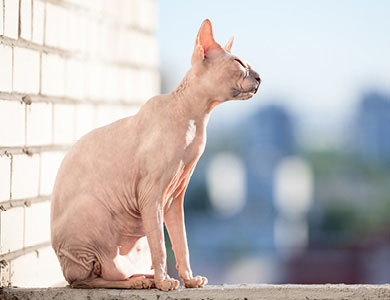
Behaviour
Like most oriental cats, Peterbalds are athletic, active, curious and playful. They need an entertaining environment and daily play time. In general, they are also very affectionate, and like to curl up on their owner's lap or under the covers, and take part in activities around the house. Generally sociable, they can live in harmony with other cats or dogs, but always require some time to adapt. Some Peterbalds are very vocal and like to converse with their owner. Living with a Peterbald is always very entertaining.
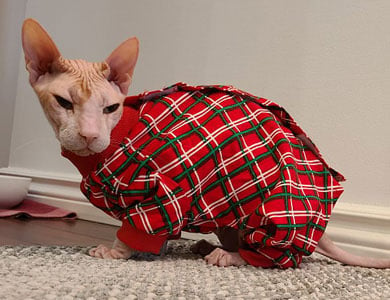
Level of maintenance (grooming)
Hairless cats often require as much if not more maintenance than cats with hair. Some Peterbalds produce a great deal of sebum. Because of their lack of fur, the skin oil isn't absorbed and remains on the skin. As a result, weekly bathing may be necessary. It is recommended that owners get hairless cats used to go in the water at a very young age to ensure that the experience is enjoyable for the rest of their life. More and more, effective skin care products are available for hairless cats. Suitable products should be used between baths, whether to moisturize the skin, prevent blackheads from forming or clean skinfolds. For the most part, products for humans are not recommended for cats, and some could even be harmful. If your hairless cat develops skin problems, don't play dermatologist. Instead, consult your veterinarian promptly.
Among other things, a lack of hair makes it difficult to maintain body temperature. Investing in a blanket or heated bed, or cat sweaters, ensuring that they are all safe, can really help cats better tolerate cold temperatures. You may also need to modify your cat's diet to make up for the energy it expends trying to stay warm, while being sure to keep the cat from gaining weight.
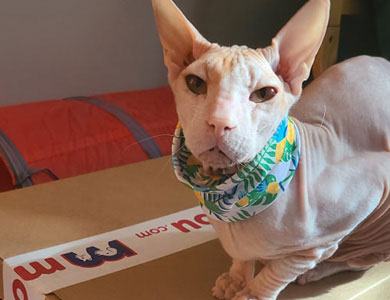
Origins
The Peterbald is the creation of Olga S. Mironova, a felinologist from St. Petersburg, Russia. Wanting a cat whose lack of hair would enhance an Oriental conformation, she experimented in 1994 by crossing a female Oriental shorthair named Radma von Jagerhov with a Donskoy male named Afinogen Myth. The parents produced two litters, and four of their kittens, with the Donskoy gene characteristics, became the founders of the Peterbald breed. Today, mating between Orientals and Donskoys is forbidden. The Peterbald is, however, well established as a new breed and can still be crossbred with Oriental or Siamese cats to expand its gene pool. For the most part, the offspring of such crossbreeding have the typical characteristics of the Peterbald and they are all recognized as such.
Unusual facts
Peterbalds, like all other hairless breeds, are not hypoallergenic. Since the molecule responsible for cat allergies is found in cat saliva, and a hairless cat grooms itself as much as a cat with hair, the molecule will be present on the cat's body and in its environment. Some breeds produce fewer allergen molecules in their saliva, but that does not seem to be the case for Peterbalds.


